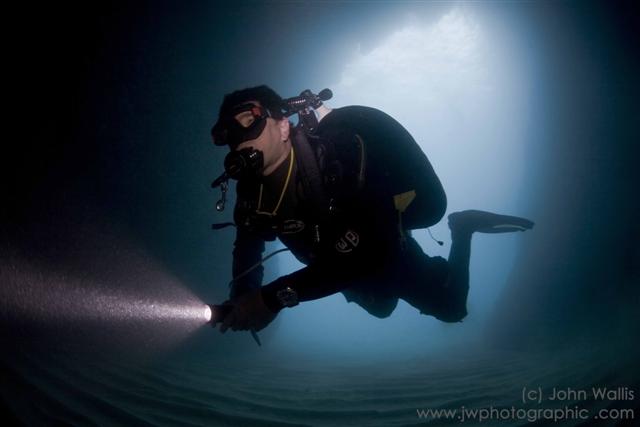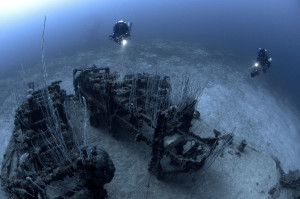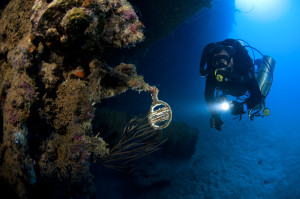News
Paul Toomer: Wreck Head

Part 6 – And He Said, “Let There Be Light.” And There Was Light.
And on one of the days – I forget which one – God said, “Let there be light.” And there was light.
I just googled it and it was the first day, which makes sense otherwise He’d have been working in the dark, and that may have been quite problematic. The light He created came in the form of a very hot ball in the sky, and for thousands of years we happily basked in its wondrous light.
The problem with this fiery ball of light is that it cannot be taken diving. It also transpires that it is simply not bright enough for our modern day needs so, after many cave and wreck divers had said many “Hail Mary’s” and knelt at the side of their twinsets, God listened. He then popped out to his shed, much to Mrs God’s annoyance, and designed the Umbilical dive light! (Um… not sure that was God actually, Paul – I’ll check. – Ed)
It’s obvious that lights are as important to a wreck diver as wheels are to a car. When we plan overhead environment dives, we place as much scrutiny on our lights as we do on our gas supplies. We work our gas into thirds so we have a safety margin. We do exactly the same with lights. We carry three lights, thirds if you like. One primary light and two backups.
There are many different designs available. I am not going to look at manufacturers per se; I am rather going to look at design features. Dive lights also have many problems related to them.
Bulbs have been one of the major weak points in lighting but they are however getting more resilient and with the advent of LED technology we are now seeing fewer problems with bulbs disintegrating. To take a light underwater you have to seal it, and we normally use O Rings. They are more often than not a rubber derivative, and unfortunately they fail every now and again; and as we know, electricity and water are not really good friends. Batteries have a limited burn time and they do run out of power while on dives. Short of wiring the light to the national grid, this is a real problem. However, we have contingencies put in place for all these failures, and these days the dive kit manufacturers are really on the case with underwater lighting. It’s bloody big business after all!!!
Over the next few instalments of Wreck Head we will discuss bulb technology, torch design, batteries, primary and secondary lights, usage and storage. I am going to keep it simple though, I am not going to blind you with science and reams of nonsense about how a battery is made. I simply want this article to give you, the reader, a little more understanding when purchasing your next light.
So I guess we should start with the primary light. This is the “Daddy” in your lighting arsenal. It does however have quite a few requirements to enable it to be safely used in a wreck.
Right now you should be pulling your dive bag out from under the bed and unpacking your array of lights. This is where things may get a little tricky for me so I’m going to be diplomatic. If you answer, “YES” to these questions I’m afraid you are about to spend more money.
1) Is your torch yellow, green, lime, pink or anything other than predominant black?
2) Does your light have a pistol grip?
3) Does it have a lantern grip?
4) Does it have one of those nice lanyard things attached to it?
5) Does it fit in your BCD pocket?
6) Did it cost £5.00 from the dive show?
7) Did it come free with a dive magazine subscription?
If you answered YES to any or God forbid, all of the questions, it’s time to go torch shopping!
We use umbilical lights for our primary lighting. These systems have a lightweight light head that is attached to an umbilical wire, which is then attached to the rechargeable battery canister. On the light head we have a “Goodman’s Handle”. This handle basically wraps around the hand enabling us to use our hand while the light is perched over the knuckles. These lights are not just good for technical divers but are ideal for recreational divers too. I assure you, having a good light makes diving so much more fun. Of course it fulfills its main goal which is to see where we are going in the dark, but it’s also a great signaling device and enhances group dynamics as we can signal from further away than we can using simple hand signals. Also, you will not believe the fish life and colours you are missing not using a light, and I mean even in broad daylight.
I, like many other technical divers, like to wear my canister on my right hand waist strap. Most canister lights come with a belt attachment as standard. I use an extra weight belt buckle to stop the light from sliding on the belt especially when I’m preparing my kit. As a nice little tip, if you don’t want to buy another buckle or you forget yours at home, simply extend the webbing of the left hand waist strap thus moving the buckle towards the right. This will trap the canister and stop it moving.
I don’t like having my canister attached to my plate or especially my twinset, as if I needed to dump the light, entanglement etc, I can simply slide it off my belt and drop the light. It makes me that little bit safer. Plus I have access to all parts of my light throughout the dive. If the light were on my twinset I would struggle to get to it. When securing a light to the twinset you stand the chance of smashing your lights when penetrating though small gaps as sell.
I recommend putting a piston clip on the light head so you can secure it to the right chest D Ring when you are not using it. There are many conflicting ideas about which hand to wear the Goodman’s Handle on, right or left. I wear mine on my right hand as wearing it on the left requires that you switch to light to the right hand when gas sharing in a twinset as you will cover the long hose. You could feed it under the long hose when you put the light on, then deploying the long hose in the event of an emergency is easy. It does however sit over any stage bottles you may be carrying as most of us wear all our stage cylinders on the left hand side. The only time I wear my light on the left hand is when I am scootering, as I need that hand clear.
So there you have it. Primary lights in a nutshell, so to speak.
As ever, all opinions expressed are my own. I am in no way trying to replace proper instruction. My opinions may differ from agency to agency and instructor to instructor and I do not wish to disrepute any of them.
As a final note, could anyone tell me what day God and AC/DC created ROCK???
Paul is the Director of Training at RAID. To find out more about the courses that RAID offers, visit www.diveraid.com.
Gear News
Introducing the TR-80, IR-50 and CS-30 Regulators from DYNAMICNORD

Whether you are a beginner or a professional diver – with the three new main regulators from DYNAMICNORD, everyone will find their favourite regulator. They all look super stylish.
Excellent performance with the TR-80
Quality and performance are the be-all and end-all for regulators. It is not for nothing that the TR stands for Tec Reg. The innovative design of the TR-80 guarantees absolute reliability – even in ice-cold waters.

Perfect breathing effort at 0.8 J/l / certified for diving in waters below 10 degrees / structural design made of solid brass for best cold protection / membrane-compensated design with dry seal of the first stage / reduced exhalation effort thanks to optimized exhalation membrane and bubble deflector / adjustable Venturi (dive/predive) and adjustment knob for individual inhalation comfort / innovative design of the front cover prevents free-flow in strong currents or when diving with scooters / design made of sandblasted brass, matt chrome finish / 2 HP and 4 LP outlets / mouthpiece made of high-quality, anti-allergic silicone for maximum comfort.


Amazing underwater adventures with the IR-50
The IR-50 is the top regulator for advanced and experienced divers. Natural breathing is the essence of this regulator.

Ideal breathing effort at 0.8 J/l /certified for diving in waters below 10 degrees / compensated membrane / adjustable venturi (dive/predive) and adjustment knob for individual inhalation comfort/ outlet valve and deflector for minimum exhalation effort and reduction of bubbles on the face / design made of sandblasted brass, matt chrome finish / 2 HP and 4 NP outlets / mouthpiece made of high-quality, anti-allergic silicone for maximum comfort.


The Workhorse – our CS-30
For diving centres and diving beginners – the workhorse stands for strong construction, reliability and robustness. Perfect for your training.

Optimal breathing effort at 0.8 J/l /recommended for diving in waters above 10 degrees / non-compensated piston / adjustable venturi (dive/predive) / outlet valve and deflector for minimum exhalation effort and reduction of bubbles on the face / design made of sandblasted brass, matt chrome finish / 1 HP and 3 NP outlets / mouthpiece made of high-quality, anti-allergic silicone for maximum comfort.


Octopus OP-30
The OP-30 is the ideal addition to all DYNAMICNORD regulators. It is identical in construction to the CS-30.

The TR-80, IR-50, CS-30 (DIN & INT) regulators and the Octopus OP-30 are available from DYNAMICNORD dealers and in the online store.
DYNAMICNORD – Your Outdoor Companion.
Marine Life & Conservation
Paul Watson Released as Denmark Blocks Japan’s Extradition Bid

Renowned anti-whaling activist Paul Watson has been released from custody in Greenland after spending five months in detention. Denmark’s Justice Ministry rejected Japan’s request for his extradition, citing insufficient guarantees that his time already served in custody would be credited against any potential sentence.
The 74-year-old Canadian-American was arrested on July 21 in Nuuk, Greenland’s capital, when his ship docked to refuel. His arrest was based on a 2012 Japanese warrant related to a 2010 encounter in Antarctic waters. Japan alleged Watson obstructed operations and caused damage to a whaling research ship during efforts to disrupt illegal whaling. Watson has consistently denied these claims, maintaining his commitment to marine conservation.
Denmark, which oversees extradition matters for Greenland, concluded that while the legal conditions for extradition were met, the lack of assurances from Japan regarding time-served credit made extradition untenable.
In a video shared by his foundation, Watson expressed gratitude and relief, saying, “After five months, it’s good to be out… and good to know they’re not sending me to Japan.” He added that the most difficult part of his time in custody was being separated from his two young sons.
Watson is a pioneering figure in marine conservation, known for founding the Captain Paul Watson Foundation in 2022 after decades of activism with the Sea Shepherd Conservation Society. His bold efforts to defend marine life have earned him widespread support, including from celebrities and conservationists. His work has also been featured in the acclaimed reality TV series Whale Wars.
Watson’s lawyer, Jonas Christoffersen, praised the decision, stating, “We are happy and relieved that Paul Watson is now free.” He added that Watson is eager to reunite with his family and continue his vital work.
The arrest occurred while Watson’s vessel, the M/Y John Paul DeJoria, was en route to the North Pacific with a team of 26 volunteers to intercept a Japanese whaling ship. His foundation described the arrest as politically motivated and emphasized that Watson’s actions were focused on ending illegal whaling practices.
Japan resumed commercial whaling in 2019 after leaving the International Whaling Commission, asserting that whale meat is a cultural tradition. Conservationists, however, continue to challenge these practices, highlighting their impact on marine ecosystems.
Despite the challenges, Watson remains steadfast in his mission to protect marine life and bring attention to whaling practices. His dedication to ocean conservation has made him a globally respected advocate for the environment.
-

 News2 months ago
News2 months agoIconic SS United States to become the World’s Largest Artificial Reef
-

 News3 months ago
News3 months agoBook Review – 52 Assignments: Underwater Photography
-

 Gear News3 months ago
Gear News3 months agoDYNAMICNORD – New German diving brand enters the British market
-

 News3 months ago
News3 months agoExploring Cenote El Pit: A Diver’s Dream
-

 Gear News3 months ago
Gear News3 months agoTry BARE drysuits (and maybe even win one!) this Friday with Sea & Sea at North West Dive Fest
-

 Marine Life & Conservation3 months ago
Marine Life & Conservation3 months agoBook Review: Coral Triangle Cameos
-

 Blogs2 months ago
Blogs2 months agoDive the Egyptian Red Sea this Autumn with Regaldive
-

 News3 months ago
News3 months ago2024 Ocean Art Underwater Photo Competition Announced




















